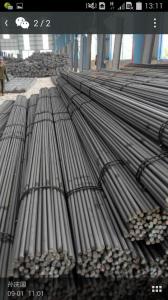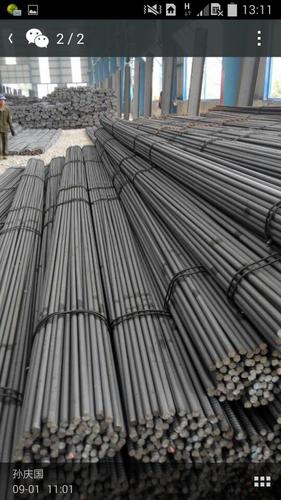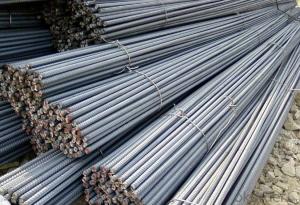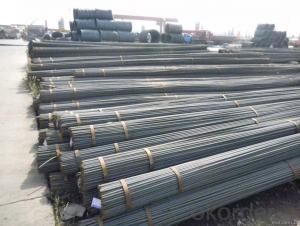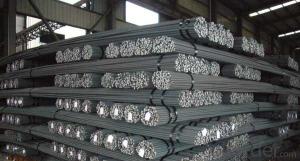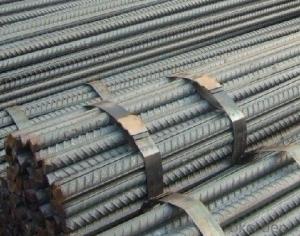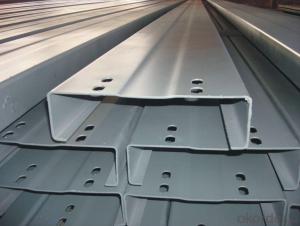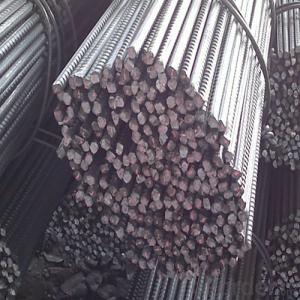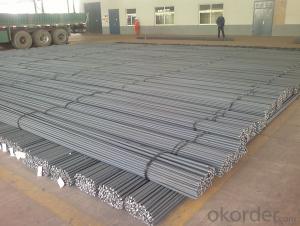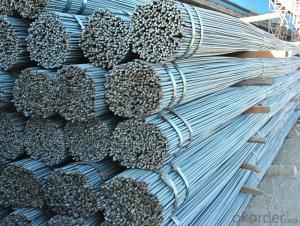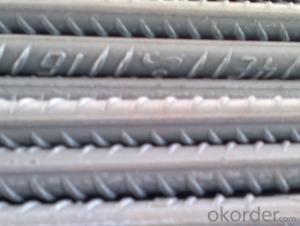Hot Rolled Deformed Bar D-BAR HRB400 HRB500 B500B B500C
- Loading Port:
- Tianjin
- Payment Terms:
- TT or LC
- Min Order Qty:
- 25 m.t.
- Supply Capability:
- 40000 m.t./month
OKorder Service Pledge
OKorder Financial Service
You Might Also Like
Product Description:
OKorder is offering Hot Rolled Deformed Bar D-BAR HRB400 HRB500 B500B B500C at great prices with worldwide shipping. Our supplier is a world-class manufacturer of steel, with our products utilized the world over. OKorder annually supplies products to European, North American and Asian markets. We provide quotations within 24 hours of receiving an inquiry and guarantee competitive prices.
Product Applications:
Hot Rolled Deformed Bar D-BAR HRB400 HRB500 B500B B500C are ideal for structural applications and are widely used in the construction of buildings and bridges, and the manufacturing, petrochemical, and transportation industries.
Product Advantages:
OKorder's Hot Rolled Deformed Bar D-BAR HRB400 HRB500 B500B B500C are durable, strong, and resist corrosion.
Main Product Features:
· Premium quality
· Prompt delivery & seaworthy packing (30 days after receiving deposit)
· Corrosion resistance
· Can be recycled and reused
· Mill test certification
· Professional Service
· Competitive pricing
Product Specifications:
Standard | GB | HRB400 | |
Diameter | 6mm,8mm,10mm,12mm,14mm,16mm,18mm,20mm, 22mm,25mm,28mm,32mm,36mm,40mm,50mm | ||
Length | 6M, 9M,12M or as required | ||
Place of origin | Hebei, China mainland | ||
Advantages | exact size, regular package, chemical and mechanical properties are stable. | ||
Type | Hot rolled deformed steel bar | ||
Brand name | DRAGON | ||
Usage and Applications of HRB400 Deformed Steel Bar:
Deformed bar is widely used in buildings, bridges, roads and other engineering construction. Big to highways, railways, bridges, culverts, tunnels, public facilities such as flood control, dam, small to housing construction, beam, column, wall and the foundation of the plate, deformed bar is an integral structure material. With the development of world economy and the vigorous development of infrastructure construction, real estate, the demand for deformed bar will be larger and larger..
Packaging & Delivery of HRB400 Deformed Steel Bar:
Packaging Detail: products are packed in bundle and then shipped by container or bulk vessel, deformed bar is usually naked strapping delivery, when storing, please pay attention to moisture proof. The performance of rust will produce adverse effect.
Each bundle weight: 2-3MT, or as required
Payment term: TT or L/C
Delivery Detail: within 45 days after received advanced payment or LC.
Label: to be specified by customer, generally, each bundle has 1-2 labels
Trade terms: FOB, CFR, CIF
FAQ:
Q1: Why buy Materials & Equipment from OKorder.com?
A1: All products offered byOKorder.com are carefully selected from China's most reliable manufacturing enterprises. Through its ISO certifications, OKorder.com adheres to the highest standards and a commitment to supply chain safety and customer satisfaction.
Q2: How do we guarantee the quality of our products?
A2: We have established an advanced quality management system which conducts strict quality tests at every step, from raw materials to the final product. At the same time, we provide extensive follow-up service assurances as required.
Q3: How soon can we receive the product after purchase?
A3: Within three days of placing an order, we will begin production. The specific shipping date is dependent upon international and government factors, but is typically 7 to 10 workdays.
Q4: What makes stainless steel stainless?
A4: Stainless steel must contain at least 10.5 % chromium. It is this element that reacts with the oxygen in the air to form a complex chrome-oxide surface layer that is invisible but strong enough to prevent further oxygen from "staining" (rusting) the surface. Higher levels of chromium and the addition of other alloying elements such as nickel and molybdenum enhance this surface layer and improve the corrosion resistance of the stainless material.
Q5: Can stainless steel rust?
A5: Stainless does not "rust" as you think of regular steel rusting with a red oxide on the surface that flakes off. If you see red rust it is probably due to some iron particles that have contaminated the surface of the stainless steel and it is these iron particles that are rusting. Look at the source of the rusting and see if you can remove it from the surface.
Images:
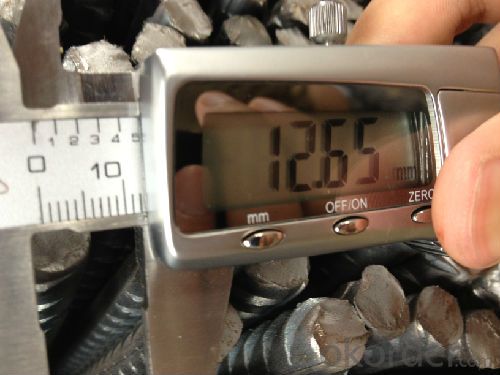
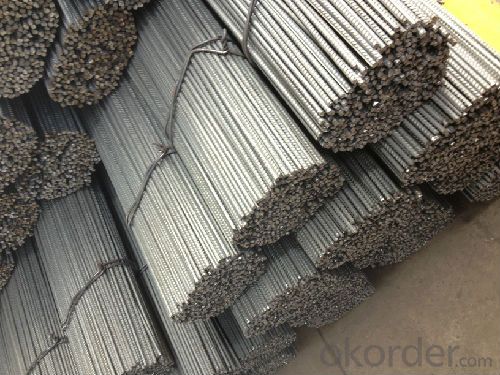

- Q: What is the process of bending steel rebars into shapes other than straight bars?
- The process of bending steel rebars into shapes other than straight bars typically involves using specialized machinery, such as a rebar bending machine or a hydraulic bender. The rebars are placed in the machine, which applies force to bend them into the desired shape. The operator may follow blueprints or use templates to ensure accurate bending. This process is commonly used in construction and concrete reinforcement projects to create custom shapes that fit specific architectural or structural requirements.
- Q: What is the maximum allowable spacing between steel rebars in columns?
- The maximum allowable spacing between steel rebars in columns is typically specified by building codes and design standards, which may vary depending on the specific project and location. However, as a general guideline, the maximum spacing between rebars in columns is commonly recommended to be no more than three times the diameter of the largest bar or 18 inches (whichever is smaller). This helps ensure proper reinforcement and structural integrity of the column.
- Q: Can steel rebars be used in residential foundation construction?
- Indeed, residential foundation construction can incorporate steel rebars. These rebars are widely utilized in reinforced concrete structures, including residential foundations, with the intention of bolstering their robustness and longevity. To reinforce and avert cracking or structural collapse, the rebars are typically positioned in a grid formation throughout the foundation. They play a crucial role in evenly distributing the building's load and enhancing its ability to withstand diverse forces, such as soil pressure, wind, and seismic activity. Furthermore, steel rebars possess corrosion resistance and are capable of enduring severe weather conditions, thereby rendering them a dependable option for residential foundation construction.
- Q: Can steel rebars be used in sound barrier walls?
- Yes, steel rebars can be used in sound barrier walls. Steel rebars provide structural strength and stability to the walls, making them suitable for withstanding external forces and vibrations. Additionally, the steel rebars help in reinforcing the concrete used in the walls, enhancing their durability and longevity.
- Q: What is the role of steel rebars in maintaining structural integrity?
- Steel rebars play a crucial role in maintaining structural integrity by reinforcing and strengthening concrete structures. They provide tensile strength to resist cracking, bending, and shearing forces, enhancing the overall stability and durability of buildings, bridges, and other infrastructure.
- Q: Are steel rebars susceptible to stress corrosion cracking?
- Yes, steel rebars are susceptible to stress corrosion cracking under certain conditions.
- Q: What is the effect of corrosion on the strength of steel rebars?
- The effect of corrosion on the strength of steel rebars is detrimental. Corrosion weakens the steel rebars by causing the formation of rust and ultimately leading to the loss of structural integrity. As corrosion progresses, the rebars may become brittle, reducing their load-bearing capacity and increasing the risk of structural failure. Therefore, regular inspection, maintenance, and corrosion prevention measures are crucial to ensure the strength and durability of steel rebars in construction projects.
- Q: What is the average weight of steel rebars per meter?
- The weight of steel rebars per meter can differ based on the particular size and type of rebar utilized. Nevertheless, as a general rule, a commonly used rebar size like a #4 (with a diameter of 1/2 inch) generally weighs approximately 0.668 kilograms per meter. Conversely, a #8 rebar (with a diameter of 1 inch) can weigh roughly 2.67 kilograms per meter. To obtain the precise weight of steel rebars per meter for a specific size and type, it is crucial to consult the manufacturer or refer to a reliable source.
- Q: What is the standard size of a steel rebar?
- The standard size of a steel rebar can vary depending on the specific application and project requirements. However, in construction and civil engineering, the most commonly used standard sizes for steel rebars are typically 10mm, 12mm, 16mm, 20mm, 25mm, and 32mm in diameter. These sizes are widely available and are used in various structural elements such as beams, columns, and slabs. Additionally, the length of a steel rebar can vary, typically ranging from 6 meters to 12 meters, depending on the project specifications. It is important to consult the project engineer or refer to the relevant building codes and standards to determine the appropriate size of steel rebar for a specific construction project.
- Q: Can steel rebars be used in high-security facility construction?
- Indeed, high-security facility construction can incorporate steel rebars. With their strength and durability, steel rebars prove to be an appropriate choice for reinforcing concrete structures. In the case of high-security facilities, like prisons or government buildings, it becomes essential to ensure that the construction materials offer utmost strength and resistance against potential threats. By providing excellent tensile strength, steel rebars effectively reinforce concrete and enhance the overall structural integrity of the building. Moreover, the flexibility of steel rebars allows customization to meet the specific security requirements of the facility, such as employing thicker rebars or increasing their spacing to bolster reinforcement. Consequently, steel rebars are frequently employed in high-security facility construction, facilitating the establishment of a sturdy and safeguarded infrastructure.
Send your message to us
Hot Rolled Deformed Bar D-BAR HRB400 HRB500 B500B B500C
- Loading Port:
- Tianjin
- Payment Terms:
- TT or LC
- Min Order Qty:
- 25 m.t.
- Supply Capability:
- 40000 m.t./month
OKorder Service Pledge
OKorder Financial Service
Similar products
Hot products
Hot Searches
Related keywords
